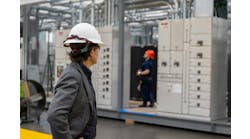Distributed Edge Data Centers Move to AI's Innovation Forefront
The data center industry is being flooded with AI demand, and edge data centers are rushing in to plug the dam, so to speak. Or something like that.
This month we learned how the "surging flood" metaphor as relates to the AI boom informed the thinking of the newly branded ark data centers, formerly known as Involta.
As heralded by a May 15 press releaes, "In response to the surging demand for edge data centers and cloud infrastructure amid the AI revolution, Involta is rebranding as ark data centers."
"The decision to relaunch as ark was driven by the insatiable growth of infrastructure requirements for space, power and compute options," said Brett Lindsey, Chief Executive Officer of ark data centers.
Lindsey said that his company will continue to address the critical need for scalable infrastructure by investing in expanding its existing locations to support enterprise and hyperscale edge capacity needed for data center, cloud and network interconnection.
As part of its rebranding, ark also launched a new website, arkdna.com, which, as reckoned by the company, "highlights the DNA of the business: d — data center infrastructure; n — network infrastructure; and a — the response to the surge of AI and automation."
The Carlyle-backed ark most recently emerged in the Green Bay market with plans to expand an existing campus with up to 20 MW of capacity.
The company said its new Wisconsin facility is poised to meet the rising colocation demands of critical high-tech industries, in what it characterizes as a desirable area for edge deployments.
As part of its growth plan, ark's roadmap contains several soon-to-be-announced projects in emerging edge markets.
"ark's assets span uniquely positioned data centers across emerging edge markets, network infrastructure and IXs to respond to the AI surge," said Lindsey. "With partnership, performance and sustainability at the forefront, ark combines the space, power, network and security with the technical acumen needed to meet the revolutionary data-driven demands of the future."
ark data centers CEO Brett Lindsey joins JSA TV at ITW 2024.
The Visionary Edge
ark and Lindsey's visionary stance toward the emergence of newly robust edge data center opportunities in response to the mounting demands of the AI era is echoed in a recent DCF 'Voices of the Industry' essay by Kevin Imboden, Global Director of Market Research and Intelligence for EdgeConneX.
In the piece, Imboden explores what edge deployment architecture might look like when AI models are in widespread production.
"Past edge deployments tended to have a connotation of a smaller size; the only needed compute was completed closer to the user, with heavier work done elsewhere in one of several key hubs," he notes, adding, "Befitting the record leasing of the past four years, the edge buildout of the future will be much larger than previously and will have more of a mixed-use component."
Imboden's vision of the newly distrubuted edge environment continues thusly:
"Dense AI workloads will function near less sophisticated requirements, with software throughout the cloud platform and the data center driving operational efficiencies. Cooling requirements could vary depending on need, with flexibility to shift between liquid and air paramount and requiring intelligent design throughout the data hall."
"Geographic requirements will continue to move as well; instead of a dense urban location, as previously suggested at the edge, a more suburban location of a metropolitan area would allow for a larger building footprint and easier scalability as needs arise."
EdgeConneX's Imboden concludes with a prediction:
"Adoptees of artificial intelligence applications will cause the edge to thrive, albeit as an evolution of the previous vision of distributed computing. Larger, denser workloads in key urban areas, complete with intelligent, efficient design options and the prospect of AI progressing the built environment, will lead to the next wave of the data center industry."
Flexnode Unveils Scalable Edge Data Center Platform
Flexnode, another company reimagining digital infrastructure for the AI era, this month unveiled its innovative edge data center platform at the International Telecoms Week (ITW) 2024 conference (May 14-17) in Maryland.
Flexnode contends its data center solution is poised to transform edge computing by optimizing factors of flexibility, scalability, and efficiency for businesses navigating dynamic and distributed environments.
"Our mission is to redefine data center procurement and consumption in the most comprehensive way possible, and we are incredibly excited to introduce Flexnode to the world at ITW," said Andrew Lindsey, Co-Founder and CEO of Flexnode.
Founded by Andrew Lindsey and Robert Mazer in 2019, Flexnode says it is reimagining the built environment through bespoke and immersive design, combined with efficient, DFMA [design for manufacturing and assembly]-centric construction, and advanced operation of high-performance, liquid-cooling-enabled data centers.
Lindsey added, "Our customized, sustainable solutions address various client challenges and requirements, spanning architectural design to operational intricacies. Our data centers are designed to support present-day needs and efficiently adapt and scale as needs and industry requirements grow and change."
With a self-professed "holistic, industry-first focus on bridging conceptual, customizable architecture with achievable, rapidly deployable engineering," Flexnode prides itself on "disrupting data center build and deployment assumptions to deliver a new era of visionary data management solutions that empower AI and other dense, demanding next-gen applications in any environment."
Flexnode has already established itself as a significant player in the next generation of the data center industry.
The company has compiled a seasoned team of experts in their respective fields. It has received numerous accolades and investments, including being named as a recipient of a Department of Energy Advanced Research Project Agency (ARPA-E) grant for $3.5M under the COOLERCHIPS program.
Key features of the Flexnode edge data center imperative, as characterized by the company, include:
- Adaptable Design: The adaptable architecture of Flexnode's solution enables businesses to deploy data center capacity incrementally, matching infrastructure growth with evolving demand seamlessly.
- Scalability: Flexnode's solution allows businesses to rapidly scale capacity up or down, ensuring they can respond to changing requirements without costly overprovisioning or downtime.
- Edge Optimization: Flexnode's solution minimizes latency and optimizes performance for latency-sensitive workloads, enhancing the end-user experience.
- Sustainability and Efficiency: By leveraging advanced cooling technologies and energy-efficient components, Flexnode delivers superior levels of efficiency, reducing operational costs and environmental impact.
Flexnode recently raised a seed investment round, led by San Francisco-based Zacua Ventures, which also included recognizable VCs such as Yes VC, and key strategic industry partners like Arup, JE Dunn, SHoP Architects and DivcoWest.
In a video posted from the floor of ITW 2024, JSA TV interviews Flexnode CEO Andrew Lindsey.

Matt Vincent
A B2B technology journalist and editor with more than two decades of experience, Matt Vincent is Editor in Chief of Data Center Frontier.





